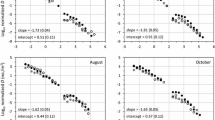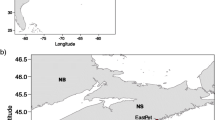Abstract
This study evaluates whether the size structure of seston (the sum of living and nonliving particles in the water column) reflects the effects of fish on wetland water quality. Using enclosures, we measured water quality and zooplankton community structure in the presence and absence of two fish species with distinct foraging strategies [benthivorous carp (Cyprinus carpio) and planktivorous mosquitofish (Gambusia holbrooki)]. Seston collected from the enclosures was counted and sized automatically with a Coulter counter, and the size structure in the range of 1–60 μm was modelled using the underlying Pareto distribution of particles. Only Cyprinus contributed to a loss of water quality (increased nutrient levels, algal and non-algal turbidity, hypoxia), while both fish species changed zooplankton community composition compared to fishless controls. However, these changes were not reflected in parameters [goodness of fit (r 2) and parameter c (slopes)] of Pareto models. Multivariate statistics suggest that seston size structure responded more to environmental gradients related to water depth but the relationships were also weak. Our overall result contrasts with the regulation of size spectra constructed from living organisms. Although seston integrates many structural and functional features of the water column, the lack of strong relationships between Pareto model parameters and water quality suggests that a size-based approach to characterise seston structure has a limited potential for assessing biota-mediated effects in wetlands in a straightforward manner.
Similar content being viewed by others
References
Alvarez-Cobelas, M., & Cirujano, S. (1996). Las Tablas de Daimiel: Ecolog a acuática y sociedad (pp. 1–368). Madrid: Spanish Ministry of Environment.
Alvarez-Cobelas, M., Rojo, C., Velasco, J.L., & Baltanas, A. (2006). Factors controlling planktonic size spectral responses to autumnal circulation in a Mediterranean lake. Freshwater Biology, 51, 131–143.
Angeler, D.G., Rodrigo, M.A., Sánchez-Carrillo, S., & Alvarez-Cobelas, M. (2002a). Effects of hydrologically confined fish on bacterioplankton and autotrophic picoplankton in a semiarid marsh. Aquatic Microbiology Ecology, 29, 307–312.
Angeler, D.G., Alvarez-Cobelas, M., Sánchez-Carrillo, S., & Rodrigo, M.A. (2002b). Assessment of exotic fish impacts on water quality and zooplankton in a degraded semi-arid floodplain wetland. Aquatic Sciences, 64, 76–86.
Ahrens, M.A., & Peters, R. H. (1991). Patterns and limitations in limnoplankton size spectra. Canadian Journal of Fisheries and Aquatic Sciences, 48, 1967–1978.
APHA (American Public Health Association, American Water Works Association, and Water Pollution Control Federation) (1989). Standard Methods for the Examination of Water and Wastewater, 17th ed. Washington D.C.
Arfi, R., & Bouvy, M. (1995). Size, composition and distribution of particles related to wind-induced resuspension in a shallow tropical lagoon. Journal of Plankton Research, 17, 557–574.
Basset, A. Sangiorgio, F., & Pinna, M. (2004). Monitoring with benthic macroinvertebrates: advantages and disadvantages of body size descriptors. Aquatic Conservation: Marine Freshwater Ecosystem, 14, 43–58.
Carignan, V., & Villard, M.-A. (2002). Selecting indicator species to monitor ecological integrity: a review. Environmental Monitoring and Assessment, 78, 45–61.
Flecker, A.S. (1996). Ecosystem engineering by a dominant detritivore in a diverse tropical stream. Ecology, 77, 1845–1854.
Flecker, A.S. (1997). Habitat modification by tropical fishes: environmental heterogeneity and variability of interaction strength. Journal of the North American Benthological Society, 16, 286–295.
Gaedke, U., & Straile, D. (1994). Seasonal changes of trophic transfer efficiencies in a plankton web derived from biomass size distributions and network analysis. Ecological Modeling, 75/76, 435–445.
Gaedke, U., Seifried, A., & Adrian, R. (2004). Biomass size spectra and plankton diversity in a shallow eutrophic lake. International Review of Hydrobiology, 89, 1–20.
Gelwick, F.P., & Matthews, W. J. (1992). Effects of an algivorous minnow on temperate ecosystem properties. Ecology, 73, 1630–1645.
Gido, K.B., & Matthews, W.J. (2000). Ecosystem effects of water column minnows in experimental streams. Oecologia, 126, 247–253.
Han, B.P., & Straškraba, M. (1998). Size dependence of biomass spectra and population density. I. The effects of size scales and size intervals. Journal of Theoretical Biology, 191, 259–265.
Kerr, S.R., & Dickie, L.M. (2001). The biomass spectrum (pp. 1–352). U.S.A.: Columbia University Press.
Knowlton, M.F., & Jones, J.R. (1997). Trophic status of Missouri river floodplain lakes in relation to basin type and connectivity. Wetlands, 17, 468–475.
Lake, P.S. (2000). Disturbance, patchiness, and diversity in streams. Journal of the North American Benthological Society, 19, 573–592.
Magoulick, D.D., & Kobza, R.M. (2003). The role of refugia for fishes during drought: a review and synthesis. Freshwater Biology, 48, 1186–1198.
Matthews, W.J., & Marsh-Matthews, E. (2003). Effects of drought on fish across axes of space, time and ecological complexity. Freshwater Biology, 48, 1232–1253.
McCauley, E. (1984). The estimation of the abundance and biomass of zooplankton in samples. In: J.A. Downing & F.H. Rigler (Eds.). A manual on methods for the assessment of secondary production in fresh waters (pp. 228–265). Oxford, England: Blackwell Scientific Publications.
Platt, T., & Denman, K. (1977). Organisation in the pelagic ecosystem. Helgoländer Wissenschaftliche Meeresuntersuchungen, 30, 575–581.
Platt, T., & Denman, K. (1978). The structure of pelagic marine ecosystems. Rapport et Proces-Verbaux Réunions. Counseil International pour I'Exporation de la Mer, 173, 60–65.
Pringle, C.M., & Hamazaki, T. (1997). The effects of fishes on algal response to storms in a tropical stream. Ecology, 78, 2432–2442.
Pringle, C.M., & Hamazaki, T. (1998). The role of omnivory in a neotropical stream: separating diurnal and nocturnal effects. Ecology, 79, 269–280.
Quintana, X.D., Comín, F. A., & Moreno-Amich, R. (2002). Biomass-size spectra in aquatic communities in shallow fluctuating Mediterranean salt marshes (Empordá wetlands, NE Spain). Journal of Plankton Research, 24, 1149– 1161.
Rasmussen, J. B., Godbout, L., & Schallenberg, M. (1989). The humic content of lake water and its quality to watershed and lake morphometry. Limnology and Oceanography, 34, 1336–1343.
Rojo, C., & Rodríguez, J. (1994). Seasonal variability of phytoplankton size structure in a hypertrophic lake. Journal of Plankton Research, 16, 317–335.
Sánchez-Carrillo, S., Alvarez-Cobelas, M., Angeler, D. G., & Vizcaíno-Munoz, C. (2000). Tasas de accreción y características de los sedimentos actuales del Parque Nacional Las Tablas de Daimiel (Ciudad Real). Estudios Geológicos, 56, 239–250.
Sánchez-Carrillo, S., Alvarez-Cobelas, M., & Angeler, D.G. (2001). Sedimentation in the semiarid freshwater wetland Las Tablas de Daimiel (Central Spain). Wetlands, 21, 112–124.
Sheldon, R.W., Prakash, A., & Sutcliffe, W. H. (1972). The size distribution of particles in the ocean. Limnology and Oceanography, 17, 327–340.
Sprules, W.G., & Munawar, M. (1986). Plankton size spectra in relation to ecosystem productivity, size and perturbation. Canadian Journal of Fisheries and Aquatic Sciences, 43, 1789–1794.
Sprules, W.G., Munawar, M., & Jin, E.H. (1988). Plankton community structure and size spectra in the Georgian Bay and North Channel system. Hydrobiologia, 163, 135–140.
Tittel, J., Zippel, B., & Geller, W. (1998). Relationships between plankton community structure and plankton size distribution in lakes of northern Germany. Limnology and Oceanography, 43, 1119–1132.
Vidondo, B., Prairie, Y.T., Blanco, J.M., & Duarte, C.M. (1997). Some aspects of the analysis of size spectra in aquatic ecology. Limnology and Oceanography, 42, 184–192.
Wienke, S.M., & Cloern, S.E. (1987). The phytoplankton component of seston in San Francisco bay. Netherlands Journal of Sea Reserach, 21, 25–33.
Author information
Authors and Affiliations
Corresponding author
Rights and permissions
About this article
Cite this article
Angeler, D.G., Sánchez-Carrillo, S., Rodrigo, M.A. et al. Does seston size structure reflect fish-mediated effects on water quality in a degraded semiarid wetland?. Environ Monit Assess 125, 9–17 (2007). https://doi.org/10.1007/s10661-006-9234-5
Received:
Accepted:
Published:
Issue Date:
DOI: https://doi.org/10.1007/s10661-006-9234-5




